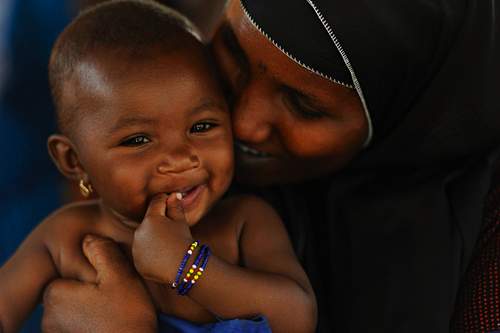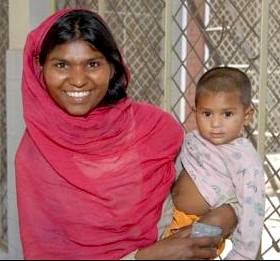
Since the start of an international effort to address maternal and child mortality, millions of lives have been saved globally, a new study shows.
In 2000, the Millennium Development Goals (MDGs) were established by the United Nations to drive maternal and child deaths down by 2015 and indeed the pace of improvement accelerated resulting in child deaths falling 48% globally between 1990 and 2013. Maternal deaths fell significantly over the same period.
The vast majority of countries saw accelerated reductions in maternal and child deaths – with child deaths declining by 3.5% per year since 2000 and maternal deaths by 2.7% per year since 2003.
The results appeared in two separate studies. “Global, regional, and national levels of neonatal, infant, and under-5 mortality during 1990–2013: a systematic analysis for the Global Burden of Disease Study 2013” and “Global, regional, and national levels and causes of maternal mortality during 1990–2013: a systematic analysis for the Global Burden of Disease Study 2013” were published May 2 in The Lancet.
The study on child mortality shows that maternal education and income growth have had a significant impact in reducing child deaths. In addition, there is a strong trend in rich and poor countries that appears to be related to technological and other advances, such as vaccine and drug innovations.
A separate IHME study found that donor spending on maternal and child health grew substantially since 2000, indicating that the decline in deaths comes at a time of increased investment.
“The fact that we are seeing faster declines in child and maternal deaths in so many countries worldwide shows that international consensus around a framework like the MDGs focuses action and makes a difference,” said Dr. Christopher Murray, Director of IHME and a co-founder of GBD. “As the world looks to 2015 and sets the post-MDG agenda, our findings provide a close look at what is working and point to where greater attention is needed to continue improving in maternal and child survival.”
Key drivers of progress in reducing child deaths at the global level include maternal education, medical and public health innovations, and rising income. For each additional year of school mothers complete, child deaths drop by more than 8%. New drugs, vaccines, and other health innovations led to 4.2 million fewer child deaths in 2013, compared to 1990; and rising per capita income led to more than 900,000 fewer child deaths. Policies that reduce anemia and malnutrition, prevent malaria during pregnancy, provide calcium and micronutrient supplementation, and encourage skilled birth attendance likely will lead to even greater improvements in child and maternal health, the researchers note.
These positive trends show that it’s possible for millions of children’s lives to be saved in a short amount of time, if current trends persist.
Key child survival (MDG 4) regional and country findings:
 Forty-five (24%) of the countries – 27 in the developing world – included in the study are on track to meet the MDG 4 target of reducing child death rates by two-thirds of 1990 levels by 2015.
Forty-five (24%) of the countries – 27 in the developing world – included in the study are on track to meet the MDG 4 target of reducing child death rates by two-thirds of 1990 levels by 2015.- Two-thirds of the global decline in child deaths since 2000 occurred in just nine countries – India, China, Ethiopia, Bangladesh, Indonesia, Pakistan, Brazil, Afghanistan, and Nigeria.
- The country with the lowest child death rate was Singapore, at about 2 deaths per 1,000.
- Turkey and China received relatively little international funding for health, yet made significant progress, reducing child deaths by the MDG goal of more than 4.4% per year since 1990.
- The 10 countries with the lowest child survival rates in 2013 were all in sub-Saharan Africa.
“While a majority of the world’s countries will not achieve MDG 4, tremendous progress has been made,” said study author Haidong Wang, Assistant Professor at IHME. “Policy changes, increased development assistance for health, expanded HIV treatment programs, and greater access to child services are all important benefits of the push to achieve these goals. In the post-MDG era, countries will be well-served to continue these efforts.”
Key maternal survival (MDG 5) regional and country findings:
- Sixteen countries – most in Central and Eastern Europe – are likely to achieve the MDG 5 target of a 75% reduction in their 1990 maternal death rate by 2015. They are Albania, United Arab Emirates, Bosnia and Herzegovina, Belarus, China, Estonia, Lebanon, Lithuania, Latvia, Morocco, Maldives, Mongolia, Oman, Poland, Romania, and Russia.
- East Asian countries have made the most progress toward MDG 5, reducing maternal mortality by an average of 9% per year since 1990.
- Maternal mortality in sub-Saharan Africa and the Caribbean either held steady or increased from 1990 to the mid-2000s – even doubling in Southern Africa – before beginning a fast decline following establishment of the MDGs.
- Maternal death rates were highest in South Sudan and lowest in Iceland.
“In the next 15 to 20 years, it is possible to bring maternal death rates down to levels currently seen in most high-income countries, but much work remains to be done,” said study author Dr. Nicholas Kassebaum, Assistant Professor at IHME.
Download the child mortality study here.
Thanks to B.S. for sending a link




















[…] outcomes among children and adolescents 19 years old and younger in 195 countries and territories from 1990 to 2015. A composite indicator of income, education and fertility – called a Sociodemographic […]